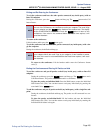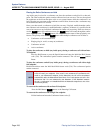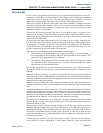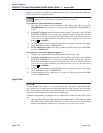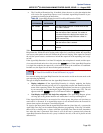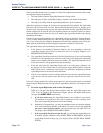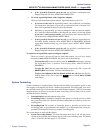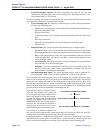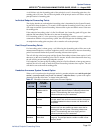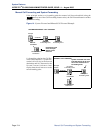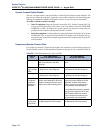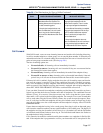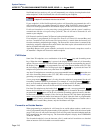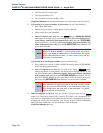
System Features
INTER-TEL
®
CS-5200/5400 ADMINISTRATOR GUIDE, ISSUE 1.1 – August 2005
Individual Endpoint Forwarding Points
Page 213
A call follows only the forwarding path of the principal, even if a forwarding point has a for-
warding path of its own. The call that originated at the principal station will follow only the
principal station’s forwarding path.
Individual Endpoint Forwarding Points
The ringing duration at each endpoint forwarding point is determined by the System Forward-
ing Advance timer (defaults to 15 seconds). If the endpoint forwarding point is busy, the call
will camp-on until the System Forwarding Advance timer expires and then it moves to the next
forwarding point.
If the endpoint forwarding point is in Do-Not-Disturb, the forwarding path will bypass that
endpoint and immediately send the call to the next forwarding point.
If a forwarding point is a voice processing system application, and the system is unable to
communicate with the voice processing system, the call will bypass the forwarding point.
An endpoint forwarding point can place calls or transfer calls to the principal.
Hunt Group Forwarding Points
If a forwarding point is a hunt group, a call following the forwarding path will be sent to the
announcement endpoint or overflow endpoint as usual; it will advance to the next forwarding
point if not answered before the System Forwarding Advance timer expires.
The call will ring at the hunt group until the System Forwarding Advance timer expires. It will
then move to the next forwarding point. The No Answer Advance timer determines how long
the call will ring at each hunt group endpoint, as usual.
If all endpoints in a hunt group forwarding point have Do-Not-Disturb or hunt group remove
enabled, the call will camp on until the System Forwarding Advance timer expires. The call
will then be sent to the next forwarding point.
Handsfree Announce System Forward Option
When a call is transferred to the principal station by another endpoint user and the principal
station's system forward is set for the “no answer” endpoint status, a system-wide option
determines what the caller hears, as shown in the table below.
Table 27.
Handsfree Announce and System Forward Options
HANDSFREE
ANNOUNCE
OPTION
SYSTEM
FORWARD
OPTION
RESULT
Disabled Intercom and/or
outside calls for-
warded
The intercom call from the transferring endpoint enters the
forwarding path after the System Forwarding Initiate timer
expires. The transferring user hears ringing and can
announce the call only if it is answered.
Enabled Outside calls for-
warded
The transferring user will place a handsfree call to the
principal station and can announce the transfer; the System
Forwarding Initiate timer does not start until the transfer is
completed.
Enabled Intercom calls for-
warded
The handsfree announce option is overridden and the
intercom call from the transferring station enters the for-
warding path after the System Forwarding Initiate timer
expires. The transferring user hears ringing and can
announce the call only if it is answered.
Enabled or
Disabled
Calls forwarded to
Voice Mail
The transfer is completed when the transferring endpoint
hangs up. The principal station's mailbox number is auto-
matically dialed.



